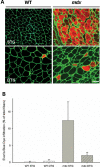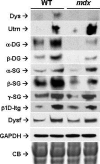Myogenic Akt signaling upregulates the utrophin-glycoprotein complex and promotes sarcolemma stability in muscular dystrophy
- PMID: 18986978
- PMCID: PMC2638781
- DOI: 10.1093/hmg/ddn358
Myogenic Akt signaling upregulates the utrophin-glycoprotein complex and promotes sarcolemma stability in muscular dystrophy
Abstract
Duchenne muscular dystrophy is caused by dystrophin mutations that lead to structural instability of the sarcolemma membrane, myofiber degeneration/regeneration and progressive muscle wasting. Here we show that myogenic Akt signaling in mouse models of dystrophy promotes increased expression of utrophin, which replaces the function of dystrophin thereby preventing sarcolemma damage and muscle wasting. In contrast to previous suggestions that increased Akt in dystrophy was a secondary consequence of pathology, our findings demonstrate a pivotal role for this signaling pathway such that modulation of Akt can significantly affect disease outcome by amplification of existing, physiological compensatory mechanisms.
Figures







Similar articles
-
Myogenic Akt signaling attenuates muscular degeneration, promotes myofiber regeneration and improves muscle function in dystrophin-deficient mdx mice.Hum Mol Genet. 2011 Apr 1;20(7):1324-38. doi: 10.1093/hmg/ddr015. Epub 2011 Jan 18. Hum Mol Genet. 2011. PMID: 21245083 Free PMC article.
-
The potential of sarcospan in adhesion complex replacement therapeutics for the treatment of muscular dystrophy.FEBS J. 2013 Sep;280(17):4210-29. doi: 10.1111/febs.12295. Epub 2013 May 13. FEBS J. 2013. PMID: 23601082 Free PMC article. Review.
-
Loss of sarcospan exacerbates pathology in mdx mice, but does not affect utrophin amelioration of disease.Hum Mol Genet. 2021 Apr 26;30(3-4):149-159. doi: 10.1093/hmg/ddaa264. Hum Mol Genet. 2021. PMID: 33432327 Free PMC article.
-
Dystrophin-glycoprotein complex: its role in the molecular pathogenesis of muscular dystrophies.Muscle Nerve. 1994 Jan;17(1):2-15. doi: 10.1002/mus.880170103. Muscle Nerve. 1994. PMID: 8264699 Review.
-
Identification of FHL1 as a therapeutic target for Duchenne muscular dystrophy.Hum Mol Genet. 2014 Feb 1;23(3):618-36. doi: 10.1093/hmg/ddt449. Epub 2013 Sep 18. Hum Mol Genet. 2014. PMID: 24087791
Cited by
-
Stabilization of the cardiac sarcolemma by sarcospan rescues DMD-associated cardiomyopathy.JCI Insight. 2019 Apr 30;5(11):e123855. doi: 10.1172/jci.insight.123855. JCI Insight. 2019. PMID: 31039133 Free PMC article.
-
Inhibition of muscle fibrosis results in increases in both utrophin levels and the number of revertant myofibers in Duchenne muscular dystrophy.Oncotarget. 2015 Sep 15;6(27):23249-60. doi: 10.18632/oncotarget.4021. Oncotarget. 2015. PMID: 26015394 Free PMC article.
-
Myogenic Akt signaling attenuates muscular degeneration, promotes myofiber regeneration and improves muscle function in dystrophin-deficient mdx mice.Hum Mol Genet. 2011 Apr 1;20(7):1324-38. doi: 10.1093/hmg/ddr015. Epub 2011 Jan 18. Hum Mol Genet. 2011. PMID: 21245083 Free PMC article.
-
Wasting mechanisms in muscular dystrophy.Int J Biochem Cell Biol. 2013 Oct;45(10):2266-79. doi: 10.1016/j.biocel.2013.05.001. Epub 2013 May 11. Int J Biochem Cell Biol. 2013. PMID: 23669245 Free PMC article. Review.
-
The potential of sarcospan in adhesion complex replacement therapeutics for the treatment of muscular dystrophy.FEBS J. 2013 Sep;280(17):4210-29. doi: 10.1111/febs.12295. Epub 2013 May 13. FEBS J. 2013. PMID: 23601082 Free PMC article. Review.
References
-
- Hoffman E.P., Brown R.H., Kunkel L.M. Dystrophin: the protein product of the Duchenne muscular dystrophy locus. Cell. 1987;51:919–928. - PubMed
-
- Ervasti J.M., Ohlendieck K., Kahl S.D., Gaver M.G., Campbell K.P. Deficiency of a glycoprotein component of the dystrophin complex in dystrophic muscle. Nature. 1990;345:315–319. - PubMed
-
- Durbeej M., Campbell K.P. Muscular dystrophies involving the dystrophin-glycoprotein complex: an overview of current mouse models. Curr. Opin. Genet. Dev. 2002;12:349–361. - PubMed
-
- Heydemann A., McNally E.M. Consequences of disrupting the dystrophin-sarcoglycan complex in cardiac and skeletal myopathy. Trends Cardiovasc. Med. 2007;17:55–59. - PubMed
Publication types
MeSH terms
Substances
Grants and funding
LinkOut - more resources
Full Text Sources
Other Literature Sources
Medical
Molecular Biology Databases

